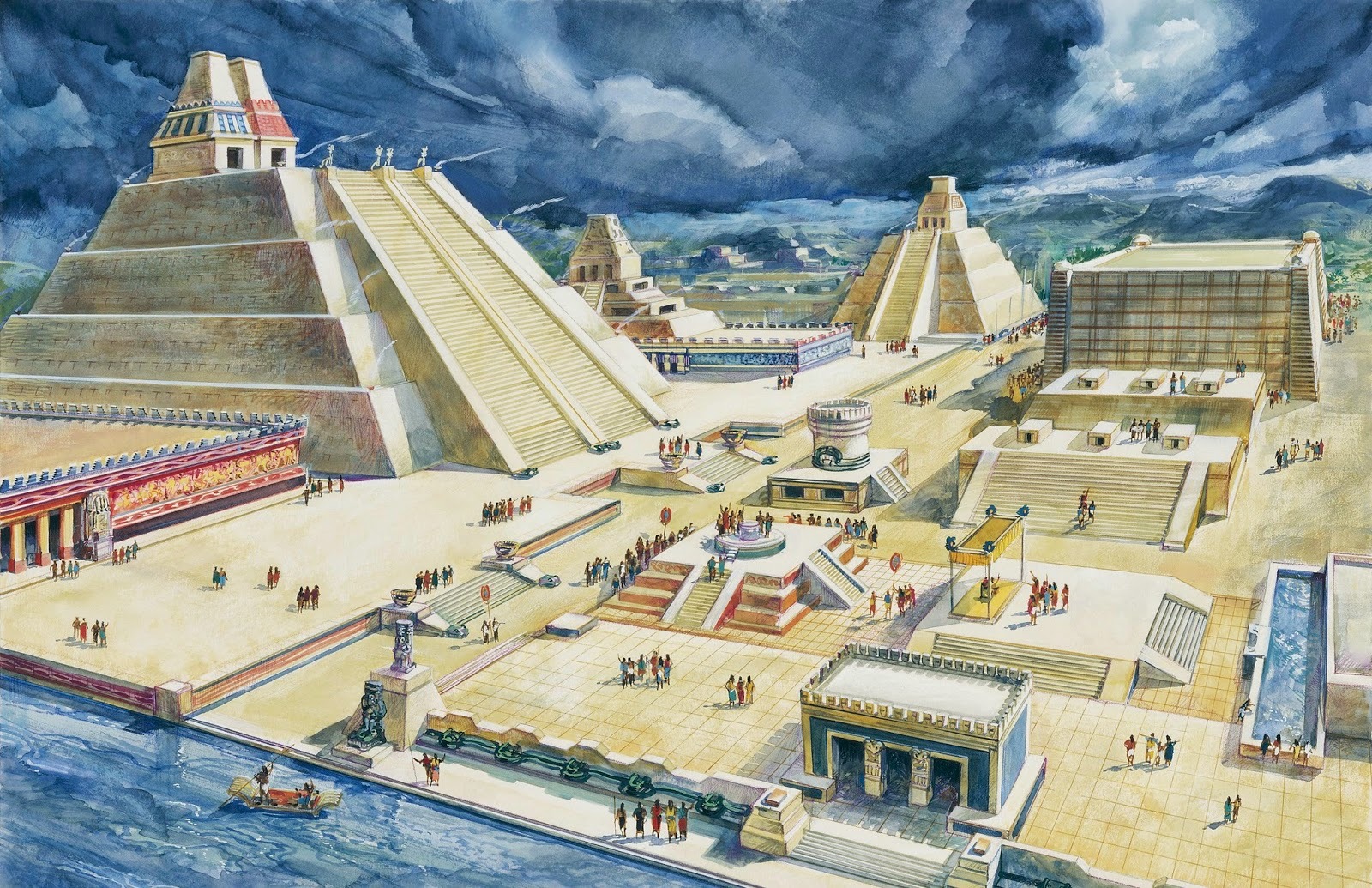The Tenochtitlan Mexico

Welcome to the breathtaking world of Tenochtitlán, once the capital of the mighty Aztec empire in the heart of Mexico. This city, founded in 1325, was a marvel of ancient engineering and culture. For centuries, Tenochtitlán was the jewel of the Americas, home to hundreds of thousands of people, and a hub of trade, religion, and politics.
The Aztecs, who arrived in the Valley of Mexico in the 12th century, saw a vision of an eagle perched on a cactus, eating a serpent - an ancient prophecy that became the emblem of their civilization. They found this vision on a swampy island in Lake Texcoco, where they built their city.
The Aztecs constructed their city with a series of artificial islands, called chinampas. These island gardens were made of soil, vegetation, and mud from the lake, which was strong enough to support buildings and structures.
As the city prospered, it grew to become a maze of canals and streets, with markets, temples, palaces, and pyramids. The city's riches included gold, silver, jewels, textiles, ceramics, and food. The Aztecs ingeniously managed to keep the city's waterways clean by using aqueducts, dams, and filtration systems.
One of the city's most spectacular sights was the Templo Mayor, a twin-pyramid complex that housed the Aztec deities. The temple was adorned with sculptures, mosaics, and frescoes. Human sacrifices were often carried out here, as the Aztecs believed that the gods needed human blood to survive.
If you're planning to visit Tenochtitlán, you won't be disappointed. Today, the site is home to Mexico City's historical center, where you can admire the Zocalo, the largest public square in Latin America, surrounded by the National Palace, the Metropolitan Cathedral, and many museums, restaurants, and shops.
History of Tenochtitlán
Tenochtitlán was founded in 1325 by the Aztecs, who migrated from the north to the Valley of Mexico. According to legend, the Aztecs saw a vision of an eagle perched on a cactus, eating a serpent, which became the emblem of their civilization.
The Aztecs built their city on a swampy island in Lake Texcoco, using a system of artificial islands, called chinampas, made of soil, vegetation, and mud from the lake. The city grew to become a maze of canals and streets, with markets, temples, palaces, and pyramids. It was a hub of trade, religion, and politics, and a marvel of ancient engineering and culture.
In 1521, the Spanish conquistador Hernán Cortés arrived in Tenochtitlán with his army and attacked the city. After a fierce battle, in which many Aztecs died from disease, war, and hunger, the city fell to the Spanish. The Aztec civilization was destroyed, and Tenochtitlán was renamed Mexico City. The Templo Mayor, the city's most magnificent monument, was razed to the ground, and a new cathedral was built on its ruins.
Travel Tips for Tenochtitlán
If you're planning a trip to Tenochtitlán, here are some travel tips that might help you:
- Check the weather forecast before your trip, as the city can get quite hot and humid.
- Wear comfortable shoes and clothes, as you'll have to walk a lot to explore the city.
- Take plenty of water and sunscreen with you, as the sun can be intense.
- Bring a camera to capture the city's beauty and history.
- Visit the National Museum of Anthropology to learn more about the Aztec civilization and its legacy.
FAQ: Frequently Asked Questions About Tenochtitlán
1. What is Tenochtitlán?
Tenochtitlán was the capital of the Aztec civilization in ancient Mexico. It was built on an island in Lake Texcoco, and it was a hub of trade, religion, and politics. It was a marvel of ancient engineering and culture, with canals, streets, markets, temples, palaces, and pyramids.
2. When was Tenochtitlán founded?
Tenochtitlán was founded in 1325 by the Aztecs, who migrated from the north to the Valley of Mexico. According to legend, the Aztecs saw a vision of an eagle perched on a cactus, eating a serpent, which became the emblem of their civilization.
3. Who destroyed Tenochtitlán?
Tenochtitlán was destroyed by the Spanish conquistadors in 1521, led by Hernán Cortés. After a fierce battle, in which many Aztecs died from disease, war, and hunger, the city fell to the Spanish. The Aztec civilization was destroyed, and Tenochtitlán was renamed Mexico City. The Templo Mayor, the city's most magnificent monument, was razed to the ground, and a new cathedral was built on its ruins.
4. Can I visit Tenochtitlán today?
Yes, you can visit the site of Tenochtitlán today in Mexico City's historical center. The site includes the Zocalo, the largest public square in Latin America, surrounded by the National Palace, the Metropolitan Cathedral, and many museums, restaurants, and shops. You can also visit the National Museum of Anthropology to learn more about the Aztec civilization and its legacy.
5. What are some interesting facts about Tenochtitlán?
Here are some interesting facts about Tenochtitlán:
- The city was built on an island in the middle of a lake, and it was a marvel of ancient engineering and culture.
- The city had canals, streets, markets, temples, palaces, and pyramids, and it was a hub of trade, religion, and politics.
- The Templo Mayor, the city's most magnificent monument, was a twin-pyramid complex that housed the Aztec deities.
- Human sacrifices were often carried out at the Templo Mayor, as the Aztecs believed that the gods needed human blood to survive.
- The city was destroyed by the Spanish conquistadors led by Hernán Cortés in 1521, and the Aztec civilization was destroyed.
If you're interested in ancient history and culture, Tenochtitlán is a must-visit destination. Its majestic pyramids, temples, and palaces are a testimony to the ingenuity, spirituality, and resilience of the Aztec people. Come and explore this fascinating city, and discover a world of wonder, mystery, and beauty.
/GettyImages-936257548-5ba3d18646e0fb00505985e2.jpg)

/tenochtitlan_map_INAH-56e42caa5f9b5854a9f8ff20.jpg)
Post a Comment for "The Tenochtitlan Mexico"